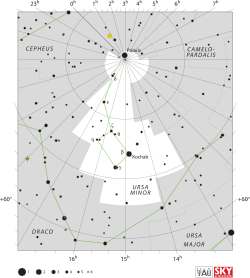Our website is made possible by displaying online advertisements to our visitors.
Please consider supporting us by disabling your ad blocker.
Ursa Minor
| Constellation | |
 | |
| Abbreviation | UMi |
|---|---|
| Genitive | Ursae Minoris |
| Pronunciation | /ˌɜrsə ˈmaɪnər/, genitive /ˌɜrsiː mɨˈnɒrɨs/ |
| Symbolism | The Little Bear |
| Right ascension | 15 |
| Declination | +75 |
| Quadrant | NQ3 |
| Area | 256 sq. deg. (56th) |
| Main stars | 7 |
| Bayer/Flamsteed stars | 23 |
| Stars with planets | 1 |
| Stars brighter than 3.00m | 3 |
| Stars within 10.00 pc (32.62 ly) | 0 |
| Brightest star | Polaris (1.97m) |
| Messier objects | 0 |
| Meteor showers | Ursids |
| Bordering constellations | Draco Camelopardalis Cepheus |
| Visible at latitudes between +90° and −10°. Best visible at 21:00 (9 p.m.) during the month of June. | |
Ursa Minor is a constellation in the northern sky. It is often called the Little Bear or the Little Dipper. Just like the related constellation Ursa Major, or the Big Bear or Big Dipper, it seems to have a long handle leading to a cup or ladle. The end of the handle is the North Star, called Polaris.
The ancient astronomer Ptolemy included Ursa Minor in his list of 48 constellations. It is now one of the 88 modern constellations. Ursa Minor is special because it includes the north celestial pole. However, this will change after several hundred years because the Earth will change the direction of its axis. That movement is called precession.[1]
- ↑ Guilherme de Almeida (2004). Navigating the Night Sky: How to Identify the Stars and Constellations. Springer. ISBN 1852337370.
Previous Page Next Page


